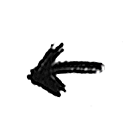From the introduction of the book,
“PICTURES” VOLUME 1
I've been taking pictures and making movies for most of my life... I started taking pictures in high school. I set up a darkroom and would lose track of time, developing and printing for hours and hours, listening to FM radio in the red 'safe light'. I must say, I never really enjoyed developing negatives. It's probably the most important part of the whole process, but what I loved was the printing - watching those images come out of the 'soup'. Seeing that proof sheet of those pictures I'd taken weeks before and forgotten all about - that's what I loved. To this day, looking at a proof sheet for the first time is like opening a Christmas present I've given to myself. What a great surprise - to see what the camera saw; what worked and what didn't; to feel the moment of the picture all over again.
Most of the photographs I take are done with a Wide-Lux camera. It's a panning, still camera. I use the 35mm version. It's got a 28mm lens that pans nearly 180 degrees. Instead of a traditional shutter, it has a slit that, as the lens pans, exposes the film.
The first time I came across one was in high school. We had been gathered together to take our class photo. The photographer had a Wide-Lux. He explained how it worked. Some kids figured if they ran very quickly, they could beat the panning lens and be in the picture twice. They were right. Years later, I started using this technique to take pictures of actors creating the theatrical masks of Tragedy and Comedy. The result was someone frowning and smiling at himself - all on one negative.
Photography took a back seat when my acting career took off and I didn't get back into it seriously until 1976, when I did the remake of King Kong. I was playing a character named Jack Prescott. Jack was a Paleontologist and he happened to carry a motor-driven Nikon with him wherever he went. In preparation for the role, I started taking pictures again.
The Wide-Lux came back into my life on my wedding day. Mark Hanauer took some photographs at our wedding party with one. I really admired them - the way they showed movement and slurred time. There was so much information in the picture - so much to look at. It's almost as if the camera has peripheral vision - registering multiple stories within a single frame.
The Wide-Lux is a fickle mistress; its viewfinder isn't accurate, and there's no manual focus, so it has an arbitrariness to it, a capricious quality. I like that. It's something I aspire to in all my work --- a lack of preciousness that makes things more human and honest, a willingness to receive what's there in the moment, and to let go of the result. Getting out of the way seems to be one of the main tasks for me as an artist.
When my wife, Sue, who was taking pictures professionally at the time, saw how much I enjoyed the photographs, she gave me a Wide-Lux as a belated wedding gift. I started carrying it around as a snap shot camera, taking pictures of family and friends. When I was making a movie, I sometimes took pictures there, too. The Wide-Lux frame is a lot like the 1:8:5 ratio of a typical movie. Because of its panning lens, it functions as sort of a bridge between still photography and moving pictures.
In 1984, when I was doing Starman, Karen Allen saw some of my Wide-Lux shots and suggested that we combine them with Sid Baldwin's (the unit photographer) to make a book for the cast and crew. Karen's brainstorm marked the beginning of a series of privately published albums. These were given, in appreciation, to the cast and crew of 16 of the films I've worked on since. Each album celebrates the work we did together. The book, 'Pictures', is a collection of some of my favorite shots from those smaller albums.






